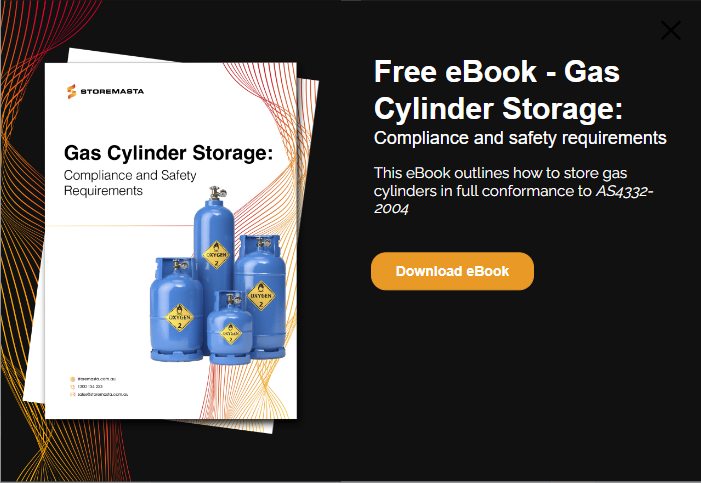Leaking gas cylinders can quickly create an asphyxiation risk to workers and personnel entering a (now) oxygen deficient atmosphere. This blog looks at how asphyxiation hazards are created by leaking gas cylinders, and how to minimise the likelihood of this happening at your workplace. Oxygen deficient environments are particularly deadly because they can impair the physical and cognitive functions of workers — often leading to fatal mistakes if operating plant and machinery or working at height.
What is an asphyxiation hazard?
The air around us that supports our life is made up of 21% oxygen, 78% nitrogen, and 1% mix of other gases. But oxygen content in the air can be depleted when other gases are released into the atmosphere, displacing the oxygen. Confined spaces are particularly vulnerable if there is no ventilation system in place to dissipate anomalies and maintain the correct percentages.
When gas under pressure leaks from a cylinder it can quickly fill a confined space and replace the oxygen. Once the atmosphere has less than 19.5% oxygen it is classified as an oxygen deficient environment — anything below 18% becoming a dangerous asphyxiation hazard. Workers or other personnel entering the area could quickly fall unconscious, stop breathing, and die.
The table below indicates the increasing risks to life (as well as cognitive impairment) when oxygen levels deplete:
- 18-21% symptoms undetectable
- 11-18% physical and intellectual impairment without the worker being aware
- 8-11% unconsciousness within a few minutes
- 6-8% workers collapse quickly and will die unless resuscitated within a few minutes
- 0-6% immediate collapse, brain damage even if resuscitated
Because many gases are both colourless and odourless, workers entering an oxygen deficient environment have very little warning the area is unsafe. At the same time their cognitive abilities become impaired without them realising. So it’s essential to make sure that handling and storage areas have adequate ventilation, and staff receive enough training and guidance to understand the potential dangers present on the job site.
IMPORTANT: Even inert gases like argon and helium (which are often considered safe because they are non-toxic, non-flammable and non-reactive) are potentially dangerous when leaked into a confined space.
Handling and storing gas cylinders correctly
Gas cylinders are heavy, bulky and awkward. Their long slim design (and their slippery surface) make them vulnerable to falling or being knocked over. Learning to handle and store gas cylinders correctly is the first step in preventing cylinders leaks.
Some essential steps include:
- Keeping cylinders upright at all time.
- Restraining gas cylinders with safety chains, straps or restraining bars.
- Never rolling cylinders or dropping them over the side of trucks.
- Ensuring valves are closed and cylinder caps are in place when the bottles are not being used.
- Using gas bottle trolleys, carts, forklifts, and other mechanical lifting devices to load and transport cylinders around the job site.
- Storing gas cylinders outside in a compliant gas bottle cage.
- Installing bollards and bump rails around your gas cylinder store to prevent the cylinders from being impacted by forklifts, vehicles, or falling objects.
- Installing a compliant mechanical ventilation system that keeps safe oxygen levels in the room whenever the area is being used or accessed by workers.
- Training staff not to carry cylinders by the valves or caps (even short distances).
IMPORTANT: AS4332-2004 - The storage and handling of gases in cylinders requires that gas cylinders must ALWAYS be protected from being knocked over or falling.
Preventing gas cylinder leaks and asphyxiation hazards
Sometimes it only takes simple (but consistent) actions and maintenance to prevent gas cylinder leaks and asphyxiation hazards. The following examples are a good place to start:
- Inspect cylinders regularly for leaks, corrosion and other physical damage.
- Check incoming deliveries of cylinders for odours, visible discharge and hissing sounds.
- Don’t accept delivery of defective cylinders, or anything outside its test date.
- Ensure valves, threading, regulators, and fittings are not worn or damaged.
- Always check regulators, fittings and appliances for compatibility with the cylinder (gas type and pressure) before making a connection.
- After connecting regulators and equipment always check for leaks.
- Remove damaged or leaking cylinders to a safe (and isolated) area. It’s also a good idea to contact suppliers requesting removal and specific advice for holding them safely.
- Only use equipment provided by the supplier for opening or closing cylinder valves.
- Never use excessive force when opening or closing cylinder valves and making connections.
IMPORTANT: Staff need to know what to do in the event of a gas leak. Hazards are compounded if using Class 2.1 Flammable Gases (you will require additional PPE and fire protection equipment) and Class 2.3 Toxic Gases (you may need PPE, first aid equipment, safety showers, eyewash stations, and breathing apparatus).
Next steps
To learn more about your workplace responsibilities when handling and storing compressed gases in cylinders, download our free eBook Gas Cylinder Storage: Compliance and safety requirements. The eBook unpacks the requirements of AS4332-2004 - The storage and handling of gases in cylinders using real world examples to help you apply it to your own workplace or job site. Download it today by clicking on the image below:
Joining the team as a Dangerous Goods Storage Consultant, Melissa Hampton became Storemasta's Marketing Manager in late 2021. With extensive knowledge and experience in chemical compliance, Melissa is responsible for leading the Marketing team and helping shape their marketing strategy. In her spare time, you can find Melissa hiking, swimming and enjoying the great outdoors in beautiful north-west Tasmania.
